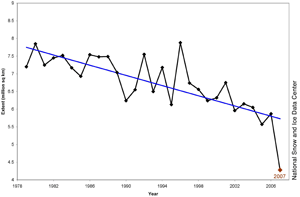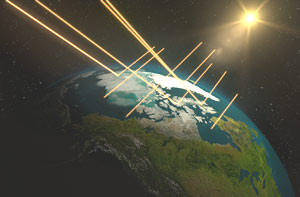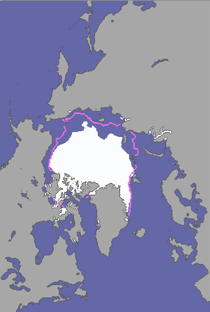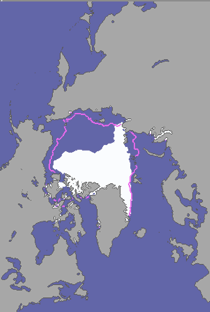| |

Melting Arctic summer sea ice reaches lowest level
1 October 2007
National Snow and Ice Data Center (NSIDC)
The 2007 Arctic summer sea ice has reached the lowest extent of perennial ice cover on record - 23 percent less than the previous low in 2005.
The area of perennial ice has been decreasing at a rate of about 10 percent each decade.
Arctic sea ice during the 2007 melt season plummeted to the lowest level since satellite measurements began in 1979.
The average sea ice extent for the month of September was 4.28 million square kilometers (1.65 million square miles), the lowest September on record.
At the end of the melt season, September 2007 sea ice was 39 percent below the long-term average from 1979 to 2000. |
| |
 |
| |
September ice extent for each year from 1979 to 2007 shows an obvious decline. The rate of decline since 1979 is now approximately 10 percent per decade, or 72,000 square kilometers (28,000 sq.miles) per year.
Image: National Snow and Ice Data Center |
 |
| |
If ship and aircraft records from before the satellite era are taken into account, sea ice may have fallen by as much as 50 percent from the 1950s.
Arctic sea ice has long been recognized as a sensitive climate indicator. NSIDC Senior Scientist Mark Serreze said, “Projections have consistently shown that as global temperatures rise, the sea ice cover will begin to shrink. While a number of natural factors have certainly contributed to the overall decline in sea ice, the effects of greenhouse warming are now coming through loud and clear.”
NSIDC scientists have also found that the date of the lowest sea ice extent, or the absolute minimum, is later in the year. This year, the five-day running minimum occurred on September 16, 2007; from 1979 to 2000, the minimum usually occurred on September 12.
One factor that contributed to this fall’s extreme decline was that the ice was entering the melt season in an already weakened state.
NSIDC Research Scientist Julienne Stroeve said, "The spring of 2007 started out with less ice than normal, as well as thinner ice ... so the stage was set for low levels of sea ice this summer.”
Another condition that accelerated ice loss this summer was an unusual atmospheric pattern, with persistent high atmospheric pressures over the central Arctic Ocean and lower pressures over Siberia.
The scientists noted that skies were fairly clear under the high-pressure cell, promoting strong melt. At the same time, the pattern of winds pumped warm air into the region. While the warm winds fostered further melt, they also helped push ice away from the Siberian shore.
NSIDC Research Scientists Walt Meier said, "While the decline of the ice started out fairly slowly in spring and early summer, it accelerated rapidly in July". By mid-August all previous records for ice extent were already shattered. |
| |
|
| |
Above: The extent of minimum summer sea ice on 21 September 2005 (left) and 14 September 2007 (right). Alaska is in the right foreground, and Greenland is at the centre top.
Images: NASA/Goddard Space Flight Center Scientific Visualization Studio.
 Click on either image to enlarge Click on either image to enlarge
 View animation of annual sea ice minimum View animation of annual sea ice minimum
Needs Quicktime, MPlayer, or Windows Media Player |
|
| |
 |
| |
Sea ice is frozen seawater floating on the surface of the ocean. Some sea ice is semi-permanent, persisting from year to year, and some is seasonal, melting and refreezing from season to season.
The sea ice cover reaches its minimum extent at the end of each summer and the remaining ice is called the perennial ice cover. |
|
| |
 |
| |
Polar ice reflects light from the sun. As this ice begins to melt, less sunlight gets reflected into space. It is instead absorbed into the oceans and land, raising the overall temperature, and fueling further melting. Image: NASA/Goddard Space Flight Center Conceptual Image Lab |
|
 |
| |
Diminished sea ice leads to opening the Northwest Passage
Arctic sea ice receded so much that the fabled Northwest Passage completely opened for the first time in human memory.
Explorers and other seafarers had long recognized that this passage, through the straits of the Canadian Arctic Archipelago, represented a potential shortcut from the Pacific to the Atlantic.
Roald Amundsen began the first successful navigation of the route starting in 1903. It took his group two-and-a-half years to leapfrog through narrow passages of open water, with their ship locked in ice through two cold, dark winters. |
|
| |
 |
| |
Sea ice cover is in a downward spiral and may have passed the point of no return. The Arctic could be free of summer sea ice by 2030. |
|
| |
 |
| |
More recently, icebreakers and ice-strengthened ships have on occasion traversed the normally ice-choked route. However, by the end of the 2007 melt season, a standard ocean-going vessel could have sailed smoothly through.
The Northern Sea Route, a shortcut along the Eurasian coast that is often at least partially open, was completely blocked by a band of ice this year.
Changes in sea ice extent, timing, thickness, and seasonal fluctuations are having an impact on people, plants, and animals in the Arctic. NSIDC Scientist and Arctic resident Shari Gearheard said, “Local people who live in the region are noticing the changes. The earlier break up and later freeze up affect when and where people can go hunting, as well as safety for travel.”
Serreze said, “We may well see an ice-free Arctic Ocean in summer within our lifetimes”. The scientists agree that this could occur by 2030. “The implications for global climate, as well as Arctic animals and people are disturbing", Serreze concluded." |
|
| |
|





